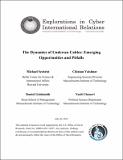| dc.contributor.author | Sechrist, Michael | |
| dc.contributor.author | Vaishnav, Chintan | |
| dc.contributor.author | Goldsmith, Daniel | |
| dc.contributor.author | Choucri, Nazli | |
| dc.date.accessioned | 2022-04-07T16:48:15Z | |
| dc.date.available | 2022-04-07T16:48:15Z | |
| dc.date.issued | 2012-07-26 | |
| dc.identifier.uri | https://proceedings.systemdynamics.org/2012/proceed/proceed.pdf | |
| dc.identifier.uri | https://hdl.handle.net/1721.1/141753 | |
| dc.description.abstract | Cyberspace is built on physical foundations that support the “virtual” manifestations we know of and use in everyday computing. Physical infrastructure can include wired, fiber optic, satellite and microwave links, as well as routing equipment. An often overlooked but critical part of the Internet infrastructure is undersea communication cable links. Undersea cables are the technology of choice to move large amounts of data around the world quickly. In the U.S., approximately 95% of all international Internet and phone traffic travel via undersea cables. Nearly all government traffic, including sensitive diplomatic and military orders, travels these cables to reach officials in the field. The problem, however, is that the undersea cable infrastructure is susceptible to several types of vulnerability, including: rising capacity constraints, increased exposure to disruption from both natural and mad-made sources, and emerging security risks from cable concentration in dense geographical networks (such as New York and New Jersey, and places like Egypt/Suez Canal.) Moreover, even under normal working conditions, there is a concern whether governance-as-usual can keep up with the future growth of Internet traffic. In this paper, we explore the impact of these problems on the dynamics of managing undersea cable infrastructure. | en_US |
| dc.description.sponsorship | This material is based on work supported by the U.S. Office of Naval Research, Grant No. N00014-09-1-0597. Any opinions, findings, conclusions or recommendations therein are those of the author(s) and do not necessarily reflect the views of the Office of Naval Research. | en_US |
| dc.language.iso | en_US | en_US |
| dc.publisher | © The System Dynamics Society | en_US |
| dc.rights | Attribution-NonCommercial-NoDerivs 3.0 United States | * |
| dc.rights.uri | http://creativecommons.org/licenses/by-nc-nd/3.0/us/ | * |
| dc.title | The dynamics of undersea cables: Emerging opportunities and pitfalls | en_US |
| dc.type | Article | en_US |
| dc.identifier.citation | Sechrist, M., Vaishnav, C., Goldsmith, D., & Choucri, N. (2012). The dynamics of undersea cables: Emerging opportunities and pitfalls. In E. Husemann, & D. Lane (Eds.), Proceedings of the 30th International Conference of the System Dynamics Society. System Dynamics Society. | en_US |
| dc.eprint.version | Author's final manuscript. | en_US |
